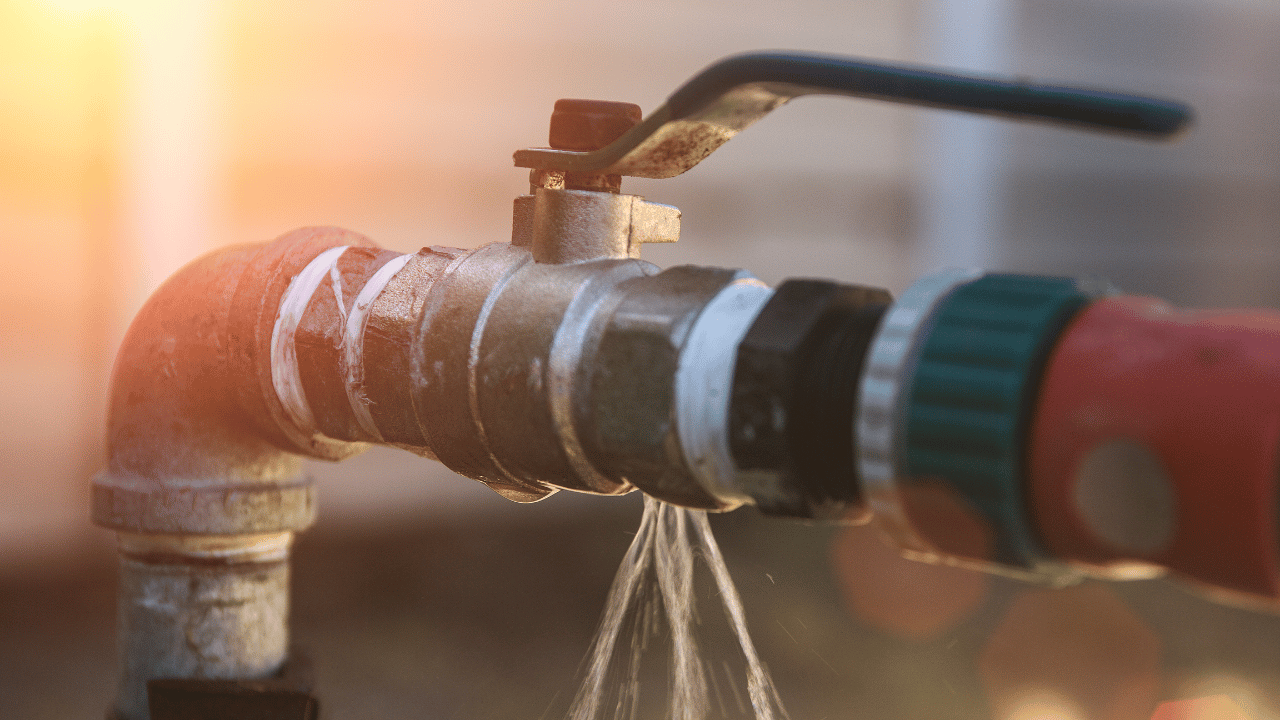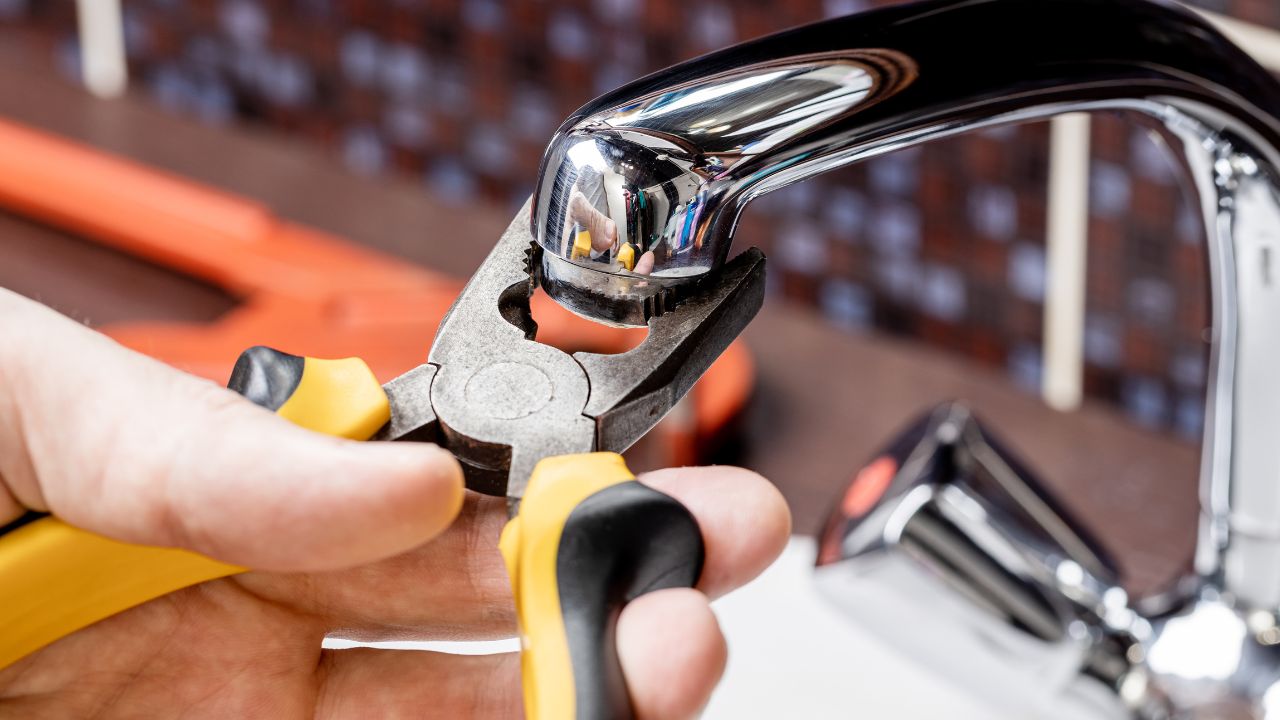Last Updated on October 21, 2023 by Pro Handyman Australia – Editorial Team
Leaky faucets are more than just an irritant that disrupts your sleep with a persistent drip or causes water to collect under your sink. If left unattended, what seems like a minor inconvenience can evolve into a significant concern for homeowners.
The Common Culprit – The Compression Faucet:
Among the various types of faucets, the compression faucet is commonly found in many kitchens. Recognizing this is key to addressing the problem efficiently.
A Cost-Effective Solution at Your Fingertips:
You might be relieved to discover that repairing a leaky faucet, especially a compression type, is not only straightforward but also remarkably budget-friendly. With the right tools and a bit of guidance, you can restore peace and functionality to your kitchen in no time.
Essential Tools for Addressing a Faucet Leak

- An adjustable wrench (for example, IRWIN brand)
- Phillips and/or flat-head screwdrivers (Halmai brand recommended)
- Penetrating oil, such as WD-40
- Replacement washers and O-rings (Tatuo is a reliable brand)
Understanding the Causes of Leaky Faucets
The Role of a Damaged Cartridge Faucets with dual handles, designed for hot and cold water, operate using a cartridge-style mechanism. Each handle contains a cartridge, which is a valve responsible for controlling water flow. A persistent drip from such a faucet may indicate a compromised cartridge.
The Issue with Broken Washers One of the most prevalent reasons for faucet leaks is malfunctioning washers. These washers are designed to be in contact with the valve seat, and as time goes by, constant friction can lead them to wear out, resulting in leaks. Moreover, the usage of improperly sized washers or incorrect installation can be a precursor to leakage issues.

Fluctuating Water Pressure If your bathroom faucet exhibits intermittent dripping, especially during specific instances or as you adjust the handles, the underlying cause could be related to the water pressure in your home.
The Malfunctioning O-Ring Dilemma Found within the faucet, the O-ring is a petite disc secured to the stem screw, ensuring the faucet handle remains in place. Much like washers, O-rings can deteriorate or become dislodged over time. If the leak seems to originate from the handle, an O-ring issue is likely at play.
The Impact of a Deteriorated Valve Seat Leaks emanating directly from the faucet’s spout can be attributed to the valve seat. This component forms a connection between the faucet and the spout. Over time, sediment accumulation can lead to the corrosion of the valve seat, thus causing leaks.
Video on How to Fix a Leaking Faucet
In the above video guide, it walks you through the step-by-step process to diagnose and fix a leaking faucet. From identifying the type of faucet you have to selecting the right tools, replacing worn-out parts, and ensuring a watertight seal, we’ll guide you through the entire repair process. Say goodbye to the annoying drip, conserve water, and save on your utility bills by tackling this common household issue. Handy tips and precautions included. Let’s put an end to that pesky leak!
Understanding Different Faucet Types

The Mechanics of Cartridge Faucets Cartridge faucets are a frequent sight in bathrooms. Their distinguishing feature is the two handles located on either side of the spout, which move vertically to regulate water flow. Inside, these faucets possess a cartridge mechanism that adjusts up and down to modulate the water’s stream.
Delving into Disc Faucets Disc faucets represent a modern evolution in faucet design, typically commanding a higher price tag than their traditional counterparts. Their hallmark is resilience and reliability. Featuring a singular lever for operation, the lever is strategically placed over a cylindrical structure, offering a sleek and contemporary look.
Exploring Ball Faucets Ball faucets utilize a ball joint mechanism to manage the blend of hot and cold water. Recognizable by their singular handle on a rounded cap atop the spout, these faucets are straightforward in operation. Elevate the handle to alter water pressure and swivel it horizontally to fine-tune the water temperature. Given their functionality, they are a popular choice for kitchens and other areas of frequent use.
Decoding Compression Washer Faucets A nod to the bygone era, compression washer faucets might be the oldest in design, but they still find favor in many homes today. Their operational mechanism involves rubber washers, which effectively block the water’s path. Unlike most modern faucets, these have two handles that move exclusively horizontally. One unique characteristic of compression washer faucets is the increasing resistance one feels on the handle as it’s turned to the off position.
Why It’s Essential to Know Your Faucet Type: Navigating the Waters of Home Maintenance
Every homeowner or renter has, at some point, been faced with a dripping, leaking, or malfunctioning faucet. The constant dripping sound can quickly become a source of annoyance, and over time, even a small leak can lead to increased water bills. While the temptation might be to call a plumber immediately, understanding the type of faucet you have can empower you to address minor issues yourself or be better prepared when seeking professional help.

1. DIY Repairs and Maintenance Different faucets come with distinct parts and mechanisms. Knowing whether you have a cartridge, ball, disc, or compression washer faucet can significantly simplify the process of troubleshooting and fixing minor issues. With the vast array of DIY videos and tutorials available online, identifying your faucet type can be the first step to resolving many common problems without the need for a costly plumber visit.
2. Efficient and Cost-effective Professional Repairs In situations where professional intervention is necessary, knowing your faucet type can ensure a more efficient repair process. Informing your plumber ahead of time allows them to come prepared with the right tools and replacement parts, potentially saving time and reducing labor costs.
3. Optimal Performance and Longevity Like any other home appliance or fixture, faucets perform best when they are adequately maintained. Recognizing your faucet type can help you understand its specific maintenance needs, ensuring it operates optimally and has a prolonged lifespan.
4. Informed Replacement Choices When the time comes to replace a faucet, having knowledge about your current type can guide your next purchase decision. Familiarity with what worked and what didn’t with your previous faucet can be invaluable. Moreover, understanding the installation intricacies of a particular faucet type can also affect your choice.
5. Enhancing Home Value For homeowners considering selling their property, ensuring that all fixtures, including faucets, are in top working condition can boost the home’s appeal. Being aware of your faucet type and its operational status can be a selling point, demonstrating attention to detail and proper home maintenance.
6. Conservation Efforts Water conservation is a growing concern globally. A malfunctioning faucet can lead to water wastage, which not only increases your bills but also impacts the environment. Recognizing your faucet type and ensuring its proper functioning can be a step towards a more sustainable household.
Steps to Resolve a Leaky Faucet:

1. Safeguard Your Space:
To avoid turning a minor leak into a significant spill, ensure you shut off your water supply before starting your repair. This means turning off both the handles located above the sink and the knobs below that regulate water from the main line.
2. Dismantle Handle Knobs:
Begin by removing any ornamental elements of the handle knobs. A flat-head screwdriver can be used to pry them off gently. Beneath each knob, you’ll find a screw securing the handle to its stem. Undo this screw and then lift off the handle using your flat-head screwdriver. If the handle proves stubborn, applying some penetrating oil can help ease its removal.
3. Investigate the Stem:
With your adjustable wrench, loosen the packing nut to reveal the stem. Depending on your faucet’s design, the stem might either pop off or need to be twisted off from the valve. It’s essential to inspect the removed components for any signs of wear or damage.
4. Inspect and Replace:
If the initial components appear in good shape, direct your attention to the O-ring and washer located inside the valve seat. These components can often be the culprits behind a leak. Replace the washer, ensuring it fits snugly within the seat.
Remember, it’s vital that any replacement washers or O-rings are the perfect match in size and design. If in doubt, examine the seat to ascertain if it needs a conical or flat washer and procure the necessary kind. Taking the old O-ring to a local hardware store to match sizes is also a wise move. Some might opt to invest in a multi-size pack of O-rings, which can be a handy purchase.
5. Reassemble and Test:
Methodically reassemble the faucet parts in the following sequence: washer/O-ring, stem, packing nut, screw, and finally, the handle. Gently turn on the knob to run the water and verify if the leak has been resolved.
Seek Expert Help if Needed:
If, despite your diligent efforts, the faucet persists in dripping, the underlying issue might be valve seat corrosion, which can cause spout leaks if left unaddressed over time. Other factors to consider include worn seals, parts becoming loose, or more severe issues like compromised plumbing. Should any of these complications arise or if the leak remains unresolved, it might be prudent to consult a professional plumber.
Conclusion
A leaking faucet, while seemingly a minor inconvenience, can culminate in significant water wastage and unexpected bills if left unaddressed. Not only does it signify potential underlying issues in our plumbing, but the persistent drip can also be a source of annoyance in our daily lives. Fortunately, with the right tools, some patience, and a step-by-step approach, fixing a leaky faucet is an achievable DIY task for many homeowners. By understanding the mechanics behind the faucet and routinely checking for wear and tear, we can extend the life of our fixtures, promote sustainability, and take pride in our home maintenance skills. However, should the problem persist or seem too complex, seeking professional help is always a prudent choice to ensure the longevity and functionality of our plumbing systems.
